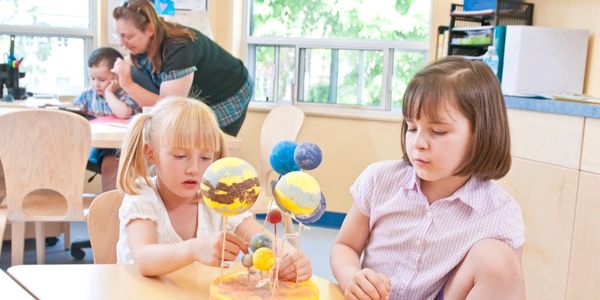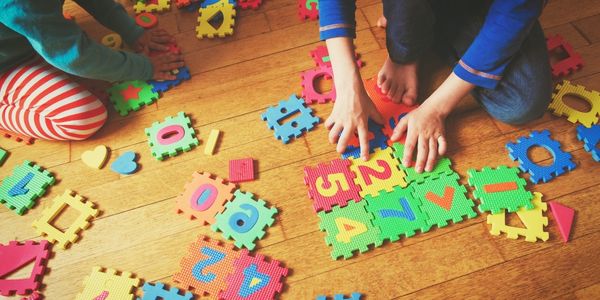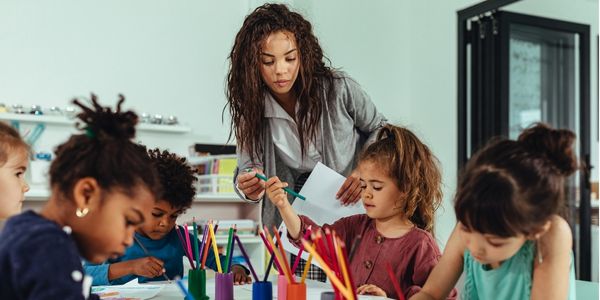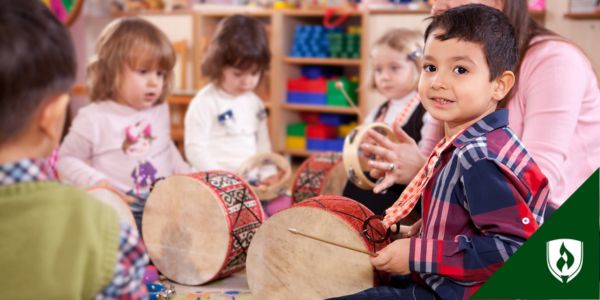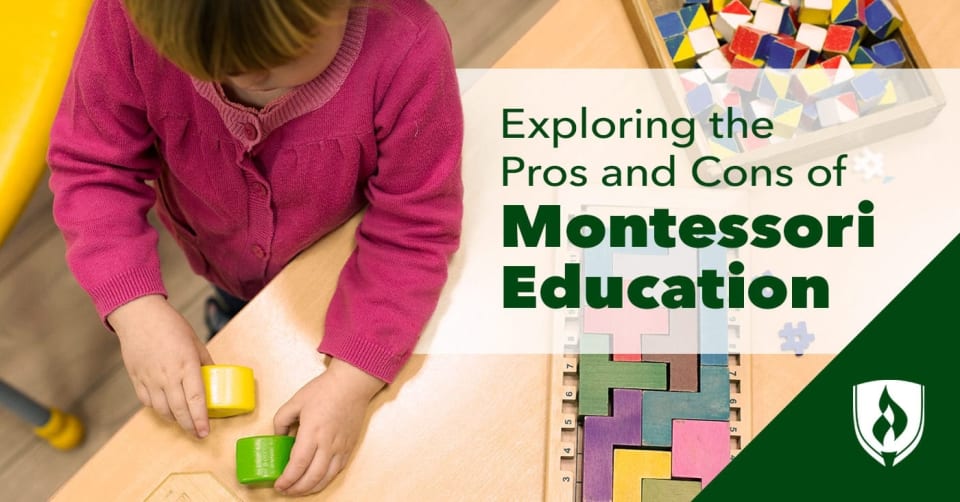
What do Jeff Bezos and preschoolers have in common? Maybe not much at a surface level, but in 2018, the e-commerce king pledged $1 billion to fund low-income Montessori preschools. You may not have known it, but along with many of the tech giants who founded Google® and famous athletes, musicians, and activists, Bezos himself was Montessori educated.
Hearing about this eye-catching donation and some of the prominent figures educated in a Montessori program might have you itching to learn more about what Montessori is and the potential pros and cons to taking this educational approach. Read on to learn more about this unique style of educational instruction.
What is the Montessori Method?
The Montessori Method was developed by Dr. Maria Montessori in the early 1900s. It’s a specific child-centered method of education that involves child-led activities (referred to as “work”), classrooms with children of varying ages and teachers who encourage independence among their pupils.
Dr. Montessori believed that children learn better when they’re choosing what to learn, and that philosophy is present in Montessori classrooms today. A Montessori classroom likely looks different than what you’re used to. Things that make it unique include:
- Various activity stations for children to choose from throughout the day.
- Teachers moving from group to group instead of standing at the front of the classroom.
- A nontraditional grading system.
- A focus on the whole student—social, emotional, intellectual and physical development are all considered.
Like with any instructional method, some teachers and parents love the approach, while others aren’t as enamored. Read on to learn more about some of the potential pros and cons of Montessori education.
The pros of Montessori education
If you ever talk to a Montessori educator, you are likely to hear a cascade of praise for the Montessori Method. Systems of education tend to inspire a real passion in the teachers who use them. But what, specifically, are the pros of a Montessori education?
An emphasis on hands-on independent learning
Montessori classrooms are somewhat famous for their beauty. Lots of natural light and space are common priorities in the classroom design. This is all done for a reason. “Creating a beautiful and accessible environment is of paramount importance, as children direct their own learning with the help of meticulously designed learning aids,” says Karen Ricks, who founded an international Montessori school in Japan.
“These materials lead young learners to the understanding of complex vocabulary and the discovery of abstract ideas through the hands-on use of concrete objects fashioned for just such a purpose,” Ricks explains.
“The best thing about a Montessori environment is that it allows for children to work, develop and learn at their own individual pace,” says Anitra Jackson, Montessori educator and writer of Chronicles of a Momtessorian. “Children are exposed to lessons, activities and materials that build upon their skill set—they progress in their development as an individual.”
What does this look like? Well, something like a giant playroom-meets-workshop. "My favorite aspect of a Montessori classroom lies within the sensory-based materials we use with our students, particularly the geometric solids, sandpaper letters and the colored bead stair used for arithmetic," says Melissa Stepien, a teacher at Sunnyside Micro-School.
“These independently-used materials provide students with the opportunity to develop their concentration and coordination in addition to more traditional academic learning,” Stepien says.
Enhanced social interaction
Have you ever noticed the way children become fascinated by what other children are doing? Montessori capitalizes on that by grouping children of different ages together in the same learning environments. Stepien says most Montessori classrooms are mixed-age and intended to foster peer-to-peer learning. This arrangement can naturally lead to growth that might not occur in a more uniformly-aged classroom.
"These mixed-aged groups allow for children to learn from one another, teach one another and develop life skills such as inclusion and acceptance," Jackson says.
Independence is a mainstay
“I valued the sense of confidence and creative freedom you develop,” says Lexi Montgomery, Montessori alum and owner at Darling Web Design. "I think a Montessori background is better for developing an entrepreneurial skillset." Since much of the learning process is self-directed, children can gain a sense of independence and confidence in their abilities much faster than in a traditional school setting.
“Students who experience a Montessori classroom tend to be more able to manage themselves and think independently,” Stepien says.
A cultivated love for learning
This educational philosophy strives to encourage a love for learning. “I think the biggest long-term impact I have seen is that Montessorians remain perpetually curious about the people and the world around them, seeing learning as an enjoyable life-long process rather than a burden that ends when a school bell rings,” Ricks says.
This particular benefit can stay with children their entire lives and become a propelling force through secondary education, a career, job training—or even just in the experiences they have and the people they encounter.
“In my experience, they have a desire and an ability to connect with a variety of people and ideas in many different situations and contexts,” Ricks says.
Inclusive of special needs
Maria Montessori’s vision for education included children with special needs from the very beginning. Not only did she study intellectual and developmental disabilities, but she was the co-director of an institute for special education teachers. It was with this background that she started her first “Casa dei Bambini” (Children’s House) for disenfranchised children in Rome in 1907. Many of the tenets of Montessori education serve students with special needs well.
Because children are grouped with others of different ages and have the same teacher for three years at a time, students with special needs tend to have less pressure to keep up with their peers and more freedom to learn and grow at their own pace. The classroom continuity can also help students with special needs form close connections within their classroom, making for a safe and stable environment in which to learn.
Montessori’s “follow the child” philosophy allows for all children—not just those with special needs—to receive an individualized education. A Montessori instructor’s lesson plan may have each child’s name on it with different goals and ideas for their unique learning style. This especially helps students with special needs to learn at their own pace.
The cons of Montessori education
Of course, this is not to say that every experience in Montessori will be a good one. On one side, teachers, classmates and school administration can seriously impact your experience for the better. And on the other side, there are some aspects of the Montessori culture that can cause issues for some.
It can be expensive
It is hard for Montessori schools to keep their prices low. “The acquisition of so many durable and high-quality learning materials, as well as the lengthy and in-depth training in the use of such items for young children is an expensive undertaking,” Ricks says. “Which is why most fully implemented Montessori programs are expensive.”
While organizations are attempting to combat the expense on behalf of students—such as the foundation created by Bezos—there aren’t many options for teachers in their continuing Montessori education or certification. Ricks says that she “would love to see a Montessori education that is accessible to all adults who wish to ‘follow the child’ and to all children, regardless of their parents' financial status.”
It’s not accessible to everyone
For some, Montessori education has gone hand in hand with being white and privileged. While this is nowhere near Maria’s original vision for Montessori, it is unfortunately the norm. Because this education philosophy flips traditional public-school curriculum on its head, most Montessori programs are private, tuition-charging and admissions-regulating. This makes it disproportionably difficult for low-income, inner-city students of color to attend such schools.
There are, however, some Montessori charter schools that are more accessible. The National Center for Montessori in the Public Sector reports that out of the 5,000 Montessori schools in the U.S., there are about 500 public programs.1 They are typically located in more diverse areas and federally-funded, removing the tuition barrier.
Curriculum may be too loose for some
While “following the child” should not be interpreted as “let kids do whatever they want,”it is still a less-structured curriculum than what you might find in a more common approach.
It is up to the teacher and assistant to make sure children progress on pace. Ideally, this give and take can work well. But it can also create room for some subjects to fall by the wayside.
“I would change the looseness of the curriculum,” Montgomery says, looking back on her own experience. “I was very under-prepared for math and science classes and over-prepared for language and arts classes.”
Independence isn’t everything
Montessori is strong in fostering a sense of independence and self-guided work. But as Montgomery points out, employment situations aren’t always like that. The entrepreneurial mindset that can be so valuable can also make it hard for students to collaborate in teams and work under a rigid authority.
“Montessori school teaches you to think on your own terms, and the workforce is a more team-oriented environment,” Montgomery says.
“Students could use more support on how to collaborate,” Stepien says. “Collaboration is not a student practice that is addressed well in Montessori curriculum.” Since collaboration is such a prized skill in today’s world, some Montessori schools might definitely push their emphasis in this area.
The open-ended structure of the classroom can be intimidating for some
Children tend to like routine and structure. Even the physical barriers of desks lined up in a row can be a comfort to certain students. Montessori classrooms are built to allow movement and change and the teachers tend to guide more than directly instruct.
While this is probably not an insurmountable obstacle, it’s definitely something to bear in mind. The hierarchy of traditional classrooms allows less freedom to the students, but it can also ensure a class environment that feels ordered, safe and routine.
Should you be a Montessori teacher?
If these pros and cons of Montessori education are really exciting you, you might want to look into becoming a Montessori teacher. But before you dive in, Ricks says it’s important to do your homework on the Montessori Method.
“There is no trademark on the name, and there are many schools calling themselves ‘Montessori’ that do not follow the true methods,” Ricks says.
“While I personally believe that Montessori is for every child, I also firmly believe it is not necessarily for every adult,” Ricks says. “In order to truly ‘follow the child,’ one must first have faith in the child and the child’s natural desire to learn.” Ricks advises every potential Montessori educator to examine themselves to see if these beliefs hold true.
If you decide you want to employ the Montessori Method, getting educated is your first step. After that, you can decide if you want to teach at an authentic Montessori school or if you just want to incorporate some Montessori principles in your teaching. Learn more about becoming a Montessori teacher or earning a Montessori credential on the American Montessori Society’s website.
If you’re not quite ready to commit to earning an Early Childhood Education (ECE) degree, take some time to learn more about the impact these professionals have on our society in our article, “5 Reasons Why the Importance of ECE Is Impossible to Ignore”
Moreover, the role of parents in a child's education is crucial. Positive parental involvement in education can further enhance a child's learning experience, fostering academic success and overall development. Explore our article on "Positive Parental Involvement in Education" to discover effective strategies and insights on how parents can actively engage in their child's educational journey. Additionally, explore what to look for in a preschool.
An Early Childhood Education degree can help you apply child-centered teaching approaches effectively.
Learn More About Our ECE Associate's Degree1National Center for Montessori in the Public Sector [accessed October, 2019] https://www.public-montessori.org/montessori/
Editor’s note: This article was originally published in 2014 and has since been updated. Insight from Ricks, Jackson, Stepien and Montgomery remain from the original.
The Early Childhood Education programs at Rasmussen University are not accredited by the NAEYC Commission on Early Childhood Associate Degree Accreditation. Rasmussen University is not a partner of NAEYC and our programs are not sponsored or endorsed by NAEYC.
Graduates of Early Childhood Education programs at Rasmussen University are not eligible for licensure as a teacher in an elementary or secondary school. A Bachelor’s degree and a state teaching license are typically required to work as a teacher in a public school and some private school settings. States, municipalities, districts or individual schools may have more stringent licensing requirements. Students must determine the licensure requirements in the state and school in which they intend to work.
Childcare facilities and the states in which they are located establish qualifications for staff who work with children, and often implement guidelines regarding age, education, experience and professional development. Students must determine the licensure requirements for the state and facilities in which they work.
This program has not been approved by any state professional licensing body, and this program is not intended to lead to any state-issued professional license. For further information on professional licensing requirements, please contact the appropriate board or agency in your state of residence.

